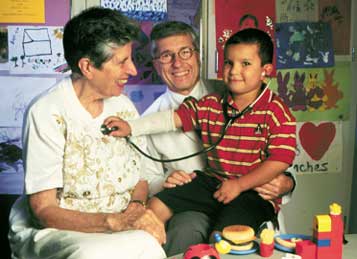
Pediatric Survival Increasing
![]()

When Dr. Margaret P. Sullivan began treating young cancer patients at M. D. Anderson in the mid-1950s, the vast majority of them died within a few weeks.
By the time Dr. W. Archie Bleyer started caring for children with cancer in 1970, the outlook was a bit better, with approximately 20 percent of youngsters expected to survive.
Today, says Dr. Bleyer, the overall cure rate for childhood cancers is approaching 85 percent, and he believes it will surpass 90 percent by the year 2010.
“Our goal is to cure every child diagnosed with cancer. I am increasingly encouraged by the tremendous progress in improving multidisciplinary therapies and supportive services, and by productive research that is helping us understand the causes of cancer and how to destroy the disease,” says Dr. Bleyer, head of the Division of Pediatrics.
While he uses the term cure with confidence, Dr. Bleyer cautions that he refers primarily to the biologic cure that can be measured through long-term survival data. Pediatric caregivers also are challenged to provide psychological and social aspects of cure.
Every child now coming to M. D. Anderson for definitive diagnoses and treatment is expected to be treated successfully, to get well, grow up and enjoy a normal life.
Powerful combinations of anti-cancer drugs developed and tested over the last three decades are the major reason for the current positive prognoses for childhood cancers, which are much less common than cancers that affect adults. Among types of pediatric cancers with improving cure rates are the acute leukemias, lymphoma, bone and soft tissue sarcomas, and brain and central nervous system tumors. For Wilms’ tumor, a rare cancer of the kidney, the cure rate is nearly 100 percent.
For years, M. D. Anderson has been a national leader in combining psychological support for young patients — and their families — with medical treatments. Helping them continue play, school and community activities during and after therapy is essential. Children’s Art Project funds have played an instrumental role in providing special psychosocial programs that move children and adolescents through their cancer experience, while maintaining their usual lifestyle.
Dr. Bleyer laments that social cure has lagged behind biologic and psychological cures. He defines social cure as “when society deals with long-term pediatric survivors as if they never had cancer.”
Job discrimination, educational prejudice and inability to obtain health insurance are common complaints of survivors. Dr. Bleyer, who holds the Mosbacher Pediatrics Chair, advocates a much broader sharing of the increasing curability of childhood cancers with lawmakers, educators, employers and insurance companies.
“We all need to work as hard, if not harder, to attain social cures as we did years ago to develop effective therapies,” he stresses.
— Mary Jane Schier

“We are able to treat most of our pediatric patients as outpatients, largely due to improved ambulatory chemotherapy. Minimizing the time our youngsters — and their families — must spend in the hospital allows them to carry on more normal activities at home and in their neighborhoods.”
— Dr. W. Archie Bleyer, head of the Division of Pediatrics at
